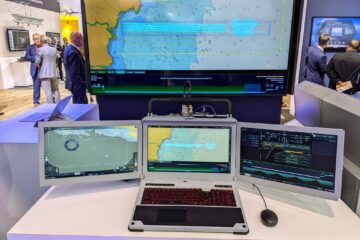According the Minister, the Belgian and Dutch Navies are set to receive:
- 15 INSPECTOR 125 unmanned surface vessels (USV),
- 10 UMS Skeldar V-200 unmanned aerial vehicles (UAV),
- 20 A-18M autonomous underwater vehicles (AUV),
- 15 T-18M towed sonars,
- 14 Seascan remotely operated vehicles (ROV),
- 42 K-STER C expendable mine disposal vehicles (EMDS),
- 1 containerized command and control (C2) system which can be deployed on shore or aboard a vessel of opportunity.
In addition, Naval News learned from the Belgian Navy that two INSPECTOR 125-S will be configured for Influence Mine Sweeping mission, each one being able to deploy one CTM sweep and one advanced acoustic generator (AAG). For this INSPECTOR 125-S variant, the waterjets are replaced by two shaft lines with propellers to increase the thrust allowing the sweep to be towed at up to 8 knots. This variant’s maximum speed is 13 knots.
The different prototypes should all be certified by mid-2022. Each system will follow a specific qualification roadmap. Knowing that some are Commercial Of-The-Shelf solutions, the Seascan and K-STER C for examples, some roadmaps could be qualified before others. Moreover, there are different types of integration to perform, such as drones on the USV and, much later, USV on the mothership. Onboard integration will be the last step, the Belgian Navy said.

The testing and qualification process will be performed by Belgium Naval and Robotics (the Naval Group-ECA Group consortium) acting as main contractor, while the Belgian Navy plans to assist. The first batch of unmanned systems is expected for the end of 2023. Sailors will familiarize themselves with those systems ahead of the delivery of the first motherships. They will be delivered after having passed the Factory, Harbour and Sea acceptance tests with shipbuilder Naval Group.
Regarding the Skeldar V-200, the operational planning is drawn up in such a way that the UAV “modules” (the aircraft and associated operators and technicians), as well as the other drones, “mainly stay on board to carry out their missions. Drones will only be disembarked to perform the necessary maintenance in or close to Zeebrugge ” the Belgian MoD press office told Naval News.
The number of UAVs was calculated in order to obtain an optimal and economically profitable operational use. At the very beginning, during the testing phase, “integration tests on ships (SAT) will be carried out in Brittany at the contractor’s shipyard,” the Belgian MoD adds.
UAV’s operators and technicians will all be sailors. According the MoD, recruitments will start this year, possibly through internal recruitment. Selected candidates will first receive an update on UAVs « in order to have the necessary prerequisites for starting the training provided in the contract”.
In addition, a specific organization within the Belgian Navy will be set up to guarantee the operational monitoring of this new capability.






